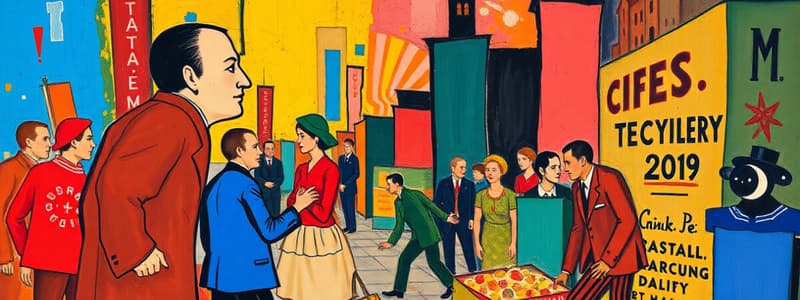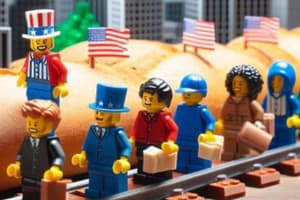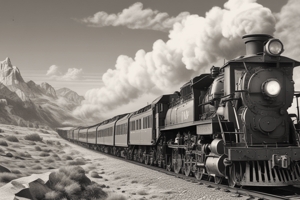Podcast
Questions and Answers
What was a significant issue faced by the older industries in the US during the 1920s?
What was a significant issue faced by the older industries in the US during the 1920s?
- Increased production levels
- Decreasing production and falling profits (correct)
- Rising profits and employment
- Government support and intervention
Which factor contributed to the bankruptcy of many farmers in the 1920s?
Which factor contributed to the bankruptcy of many farmers in the 1920s?
- Successful crop yields leading to price drops
- Increased international demand for American crops
- Government subsidies for excess production
- Mechanization and overproduction of goods (correct)
What was one of the consequences of the Republican government's laissez-faire policies?
What was one of the consequences of the Republican government's laissez-faire policies?
- Support for foreign competition
- Increased government spending on industry
- Government intervention in farming practices
- A tariff war with European countries (correct)
How did market saturation of consumer goods impact the economic situation in the late 1920s?
How did market saturation of consumer goods impact the economic situation in the late 1920s?
What major flaw existed within the US banking system during the 1920s?
What major flaw existed within the US banking system during the 1920s?
What was the belief held by many regarding the US economy during the 1920s?
What was the belief held by many regarding the US economy during the 1920s?
Why did tariffs imposed by the US government initially seem beneficial?
Why did tariffs imposed by the US government initially seem beneficial?
What percentage of people were below the poverty line in the 1920s, indicating wealth disparity?
What percentage of people were below the poverty line in the 1920s, indicating wealth disparity?
What was one significant factor that contributed to the inability of many individuals to repay their loans during the stock market speculation?
What was one significant factor that contributed to the inability of many individuals to repay their loans during the stock market speculation?
Which economic event signaled the first downturn in industrial output in four years?
Which economic event signaled the first downturn in industrial output in four years?
How did the wealth gap impact consumer spending in the late 1920s?
How did the wealth gap impact consumer spending in the late 1920s?
What was the impact of banks lending to speculators during this period?
What was the impact of banks lending to speculators during this period?
What was one consequence of falling farm profits in the late 1920s?
What was one consequence of falling farm profits in the late 1920s?
Which of the following best describes the state of car sales leading up to the Wall Street Crash?
Which of the following best describes the state of car sales leading up to the Wall Street Crash?
What was a contributing factor to market saturation in the 1920s?
What was a contributing factor to market saturation in the 1920s?
What was the primary reason speculators bought shares using borrowed money?
What was the primary reason speculators bought shares using borrowed money?
What effect did the downturn in share values have on public confidence in the economy?
What effect did the downturn in share values have on public confidence in the economy?
What was the total number of speculators by 1929?
What was the total number of speculators by 1929?
What was the Babson break and why was it generally ignored?
What was the Babson break and why was it generally ignored?
How did speculators contribute to the rise in share prices?
How did speculators contribute to the rise in share prices?
What was the approximate volume of shares bought and sold on 19th October 1929?
What was the approximate volume of shares bought and sold on 19th October 1929?
What was the state of the stock market on Tuesday, 22nd October after the preceding weekend's sell-off?
What was the state of the stock market on Tuesday, 22nd October after the preceding weekend's sell-off?
In what manner did the advertisement spending of $3 billion in 1929 reflect the economic condition?
In what manner did the advertisement spending of $3 billion in 1929 reflect the economic condition?
What percentage of their own money did speculators typically invest when buying shares on margin?
What percentage of their own money did speculators typically invest when buying shares on margin?
What was one immediate consequence of selling shares to pay back bank loans during the market crash?
What was one immediate consequence of selling shares to pay back bank loans during the market crash?
How did the trading volume on October 29th reflect investor sentiment?
How did the trading volume on October 29th reflect investor sentiment?
What did President Hoover’s October 26 speech aim to do regarding the stock market?
What did President Hoover’s October 26 speech aim to do regarding the stock market?
What was Hoover's primary belief about governmental intervention in economic crises?
What was Hoover's primary belief about governmental intervention in economic crises?
What event led to a rush of selling shares on October 24?
What event led to a rush of selling shares on October 24?
What was a significant factor contributing to the surprise of the events on October 28 and 29?
What was a significant factor contributing to the surprise of the events on October 28 and 29?
What approach did Hoover believe was appropriate for helping those who lost their jobs?
What approach did Hoover believe was appropriate for helping those who lost their jobs?
What was one of the results of widespread speculation in the stock market prior to the crash?
What was one of the results of widespread speculation in the stock market prior to the crash?
Flashcards
Decline of Old Industries
Decline of Old Industries
Industries like coal mining struggled during the 1920s due to low production, falling profits, and job losses. This led to higher unemployment and a widening wealth gap, with over 42% of people living below the poverty line.
Struggling Farming Sector
Struggling Farming Sector
Despite 60% of the population being involved in agriculture, farming struggled in the 1920s. Overproduction caused by new machinery like tractors led to falling prices and profits, pushing some farmers into bankruptcy.
Laissez-Faire Policies
Laissez-Faire Policies
The Republican government followed a hands-off approach to the economy, not intervening to help struggling industries like farming. This inaction hampered their survival.
Tariff Wars
Tariff Wars
Signup and view all the flashcards
Consumer Goods Saturation
Consumer Goods Saturation
Signup and view all the flashcards
Unregulated Banking
Unregulated Banking
Signup and view all the flashcards
Speculation and Overconfidence
Speculation and Overconfidence
Signup and view all the flashcards
Market Saturation
Market Saturation
Signup and view all the flashcards
Overborrowing
Overborrowing
Signup and view all the flashcards
Falling Farm Profits
Falling Farm Profits
Signup and view all the flashcards
Wealth Gap
Wealth Gap
Signup and view all the flashcards
Irresponsible Bank Lending
Irresponsible Bank Lending
Signup and view all the flashcards
Bank Closures
Bank Closures
Signup and view all the flashcards
Slowdown in Car Sales
Slowdown in Car Sales
Signup and view all the flashcards
Fall in Industrial Output
Fall in Industrial Output
Signup and view all the flashcards
The Role of Advertising in 1929
The Role of Advertising in 1929
Signup and view all the flashcards
Who Were Speculators?
Who Were Speculators?
Signup and view all the flashcards
How Did Speculators Buy Shares?
How Did Speculators Buy Shares?
Signup and view all the flashcards
Why Did Speculators Buy Shares?
Why Did Speculators Buy Shares?
Signup and view all the flashcards
Impact of Speculators on the Market
Impact of Speculators on the Market
Signup and view all the flashcards
The Babson Break (1929)
The Babson Break (1929)
Signup and view all the flashcards
The Stock Market Crash Timeline (19th-29th October 1929)
The Stock Market Crash Timeline (19th-29th October 1929)
Signup and view all the flashcards
Black Thursday
Black Thursday
Signup and view all the flashcards
Black Tuesday
Black Tuesday
Signup and view all the flashcards
Hoover's Response
Hoover's Response
Signup and view all the flashcards
Bank's Role in the Crash
Bank's Role in the Crash
Signup and view all the flashcards
Market Confidence and Hoover's Speech
Market Confidence and Hoover's Speech
Signup and view all the flashcards
Impact of Market Decline
Impact of Market Decline
Signup and view all the flashcards
What Led to the Surprise?
What Led to the Surprise?
Signup and view all the flashcards
Study Notes
Weaknesses of the US Economy in the 1920s
- Older industries like coal mining faced declining production, falling profits, and rising unemployment.
- Farm incomes dropped due to overproduction and mechanization, leading to bankruptcies.
- Republican policies of laissez-faire economics avoided government intervention to support struggling industries.
- Protective tariffs, intended to shield American producers, led to international trade conflicts that hurt exports.
- Overproduction saturated consumer markets, as many people could not afford goods.
- The banking system was poorly regulated, contributing to the failure of many small banks.
- Excessive speculation and faith in economic growth fueled the stock market boom, making people prone to risk and contributing to the crash.
Problems of Late 1928/Early 1929
- Slowdowns in car sales illustrated a decrease in consumer spending power.
- Falling industrial output signaled that businesses were experiencing decreased production and sales.
- Stock prices fell notably beginning in 1928.
- Falling farm profits and rising unemployment in agriculture further weakened the economy.
- Wide wealth gap exacerbated problems; many were unable to afford consumer goods.
- Banks inappropriately lent money to speculators, increasing the risk of bank failures.
- Excessive advertising spending suggested a demand problem, not necessarily a supply one.
Speculators and the Stock Market
- Speculators borrowed money ("on margin") to buy shares in companies they hoped would rise in value.
- Speculators drove up share prices through their activity and anticipation of further gains.
- By 1929, there were 20 million speculators.
- Speculative buying encouraged further investment.
Wall Street Crash of 1929 (October 19th - 29th)
- Increased selling of shares led to a sharp decline in share prices.
- Shares continued to fall on Monday 21st and Tuesday 22nd October.
- Significant share selling on Wednesday 23rd and Thursday 24th October.
- Banks tried to stabilize the market, but fears and panic selling prevailed.
- Many speculators lost their money due to high share value volatility.
- On October 29th, over 16 million shares were traded, resulting in dramatic losses.
President Hoover's Actions
- Hoover advocated for rugged individualism and less government intervention in the economy.
- He believed that charities and state governments should address economic problems.
- Hoover did create some government infrastructure projects to create jobs, but they were not enough to solve the crisis.
Other Economic Factors
- The 1930 Hawley-Smoot tariffs were designed to protect US goods but created trade conflicts.
- The Reconstruction Finance Corporation (RFC) was in place to provide $1.5 billion in loans to support failing businesses.
- The Farmer's Board bought surplus crops to keep prices up.
Studying That Suits You
Use AI to generate personalized quizzes and flashcards to suit your learning preferences.




